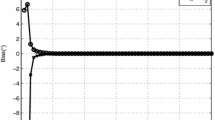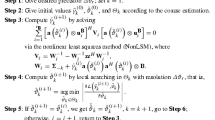Abstract
In this paper, we proposed a new direction-of-arrival estimation approach using Volterra signal model in spatial domain. The new technique basically uses additionally the second-order terms of Volterra series to produce augmented Volterra snapshots, the extension for higher-order case is straightforward. The resolution of the proposed method is high comparing with the standard multiple signal classification (MUSIC) algorithm and the 2q-MUSIC algorithm. Simulation results are presented to show the performance of the proposed technique.










Similar content being viewed by others
Explore related subjects
Discover the latest articles, news and stories from top researchers in related subjects.References
Birot, G., Albera, L., & Chevalier, P. (2010). Sequential high-resolution direction finding from higher order statistics. IEEE Transactions on Signal Processing, 58(8), 4144–4155.
Chevalier, P., & Ferreol, A. (1999). On the virtual array concept for the fourth-order direction finding problem. IEEE Transactions on Signal Processing, 47(9), 2592–2595.
Chevalier, P., Albera, L., Ferreol, A., & Comon, P. (2005). On the virtual array concept for higher order array processing. IEEE Transactions on Signal Processing, 53(4), 1254–1271.
Chevalier, P., Ferreol, A., & Albera, L. (2006). High-resolution direction finding from higher order statistics: The 2q -MUSIC algorithm. IEEE Transactions on Signal Processing, 54(8), 2986–2997.
Chevalier, P., Ferreol, A., Albera, L., & Birot, G. (2007). Higher order direction finding from arrays with diversely polarized antennas: The pd-2q-music algorithms. IEEE Transactions on Signal Processing, 55(11), 5337–5350.
Diniz, P. S. R. (2008). Adaptive filtering : Algorithms and practical implementation. Berlin: Springer.
Dogan, M. C., & Mendel, J. M. (1995a). Applications of cumulants to array processing. I. Aperture extension and array calibration. IEEE Transactions on Signal Processing, 43(5), 1200–1216.
Dogan, M. C., & Mendel, J. M. (1995b). Applications of cumulants to array processing. II. Non-gaussian noise suppression. IEEE Transactions on Signal Processing, 43(7), 1663–1676.
Gonen, E., Mendel, J. M., & Dogan, M. C. (1997). Applications of cumulants to array processing. IV. Direction finding in coherent signals case. IEEE Transactions on Signal Processing, 45(9), 2265–2276.
Kaveh, M., & Barabell, A. (1986). The statistical performance of the MUSIC and the minimum-norm algorithms in resolving plane waves in noise. IEEE Transactions on Acoustics, Speech, and Signal Processing, 34(2), 331–341.
Lee, H. B., & Wengrovitz, M. S. (1990). Resolution threshold of beamspace MUSIC for two closely spaced emitters. IEEE Transactions on Acoustics, Speech, and Signal Processing, 38(9), 1545–1559.
Liu, Z., Ruan, X., & He, J. (2013). Efficient 2-d doa estimation for coherent sources with a sparse acoustic vector-sensor array. Multidimensional Systems and Signal Processing, 24(1), 105–120.
Mathews, V. J. (1991). Adaptive polynomial filters. IEEE Signal Processing Magazine, 8(3), 10–26.
Pal, P., & Vaidyanathan, P. P. (2012). Multiple level nested array: An efficient geometry for th order cumulant based array processing. IEEE Transactions on Signal Processing, 60(3), 1253–1269.
Porat, B., & Friedlander, B. (1991). Direction finding algorithms based on high-order statistics. IEEE Transactions on Signal Processing, 39(9), 2016–2024.
Rao, B. D., & Hari, K. V. S. (1989). Performance analysis of root-MUSIC. IEEE Transactions on Acoustics, Speech, and Signal Processing, 37(12), 1939–1949.
Schmidt, R. (1986). Multiple emitter location and signal parameter estimation. IEEE Transactions on Antennas and Propagation, 34(3), 276–280.
Stoica, P., & Nehorai, A. (1989). MUSIC, maximum likelihood, and Cramer–Rao bound. IEEE Transactions on Acoustics, Speech, and Signal Processing, 37(5), 720–741.
Stoica, P., & Nehorai, A. (1990). MUSIC, maximum likelihood, and Cramer–Rao bound: further results and comparisons. IEEE Transactions on Acoustics, Speech, and Signal Processing, 38(12), 2140–2150.
Van Trees, H. L. (2002). Detection, estimation, and modulation theory, part IV, optimum array processing. London: Wiley.
Xu, X. L., & Buckley, K. M. (1992). Bias analysis of the MUSIC location estimator. IEEE Transactions on Signal Processing, 40(10), 2559–2569.
Zhang, X., Chen, C., Li, J., & Xu, D. (2012). Blind DOA and polarization estimation for polarization-sensitive array using dimension reduction MUSIC. Multidimensional Systems and Signal Processing, 1–16. doi:10.1007/s11045-012-0186-3.
Zhang, Q. T. (1995). Probability of resolution of the MUSIC algorithm. IEEE Transactions on Signal Processing, 43(4), 978–987.
Zheng, Z., & Li, G. (2012). Fast DOA estimation of incoherently distributed sources by novel propagator. Multidimensional Systems and Signal Processing, 1–9. doi:10.1007/s11045-012-0185-4.
Author information
Authors and Affiliations
Corresponding author
Appendix: The dimension of the signal subspace \(N_s\)
Appendix: The dimension of the signal subspace \(N_s\)
The dimension of the signal subspace \(N_s\) is equivalent to the Rank of \(\mathbf{R}_v\) for the noiseless case. In order to analysis the Rank of \(\mathbf{R}_v\), let us look at some of the properties of Rank:
-
(1)
For a matrix \(\mathbf{{B}}\in \mathbb{C }^{m\times n}\), \(\mathrm{Rank}(\mathbf{{B}})\le \min \left(m,n\right).\)
-
(2)
For two matrices \(\mathbf{{B}}\in \mathbb{C }^{m\times n}\) and \(\mathbf{{C}}\in \mathbb{C }^{n\times t}\), \(\mathrm{Rank}(\mathbf{{BC}})\le \min \big (\mathrm{Rank}(\mathbf{{B}}),\mathrm{Rank}(\mathbf{{C}})\big ).\)
-
(3)
For two matrics \(\mathbf{{B}}\in \mathbb{C }^{m\times n}\) and \(\mathbf{{D}}\in \mathbb{C }^{t\times n}\), \(\mathrm{Rank}\left(\left[\begin{array}{c} \mathbf{{B}}\\ \mathbf{{D}}\end{array}\right]\right)\le \min \left(m+t,n\right).\)
For the noiseless case, the Volterra snapshots \(\mathbf{{X}}_{v}\) is given by
where \(\mathbf{S} = \left[\mathbf{s}(1),\, \mathbf{s}(2), \ldots , \mathbf{s}(k), \ldots , \mathbf{s}(K)\right]\) and \(\odot \) denotes Khatri-Rao product, which is a column-wise Kronecker product.
The estimated noiseless covariance matrix is obtained by
Based on the properties (1) and (2) of Rank, \(\mathrm{Rank}\big (\mathbf{{A}}(\theta )\big )\le L\) and \(\mathrm{Rank}(\mathbf{{S}})\le L\), then \(\mathrm{Rank}\big (\mathbf{{A}}(\theta )\mathbf{{S}}\big )\le L\).
The Kronecker product can be rewritten as
where \(\mathrm{vec}\left(\mathbf{X}\right)\) denotes the vectorization of the matrix \(\mathbf{X}\) formed by stacking the columns of \(\mathbf{X}\) into a single column vector.
Since
then the rank of \(\mathbf{{S}~\odot }~\mathbf{{S}}^*\) is
and
and
Based on the above property \((3)\), we obtain
The dimension of the signal subspace
The number of noise eigenvectors \(N_{e}\) used to perform DOA estimation is given by
Table 1 shows the dimension of the signal subspace \(N_s\) and the number of noise eigenvectors \(N_{e}\) used to perform DOA estimation, for different number of sensors \(M\) and different number of sources \(L\).
Rights and permissions
About this article
Cite this article
Wen, F., Ng, B.P. A new DOA estimation approach using Volterra signal model. Multidim Syst Sign Process 25, 741–758 (2014). https://doi.org/10.1007/s11045-013-0228-5
Received:
Revised:
Accepted:
Published:
Issue Date:
DOI: https://doi.org/10.1007/s11045-013-0228-5




